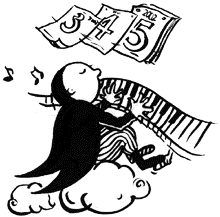It’s that time of year again… summer (at least in the northern hemisphere) has given way to autumn and most everyone has now heeded the call to “get back to proper work”. Time, again, for strategic planning, new projects, new launches, renewed commitment to professional development and attending company/organization and association meetings. Such events often include formal kick-offs, roll-outs and conferences and you…you lucky duck…may be invited (or volunteer) to sit on a committee designing the program, selecting the speakers or, perhaps, say a few words or give a formal speech yourself!
It’s typical that individuals in positions of know-how and/or official leadership address attendees at such gatherings; this I know because, as a professional guest speaker on these programs, I’m usually present to hear their speeches. Although I suppose I shouldn’t be…I confess, I continue to be surprised (and even mildly wince at times), at the number of individuals who address groups in a weak and ineffective manner. While it’s understandable that many who provide opening, closing or master-of-ceremonies-style comments don’t have the “spit and polish” prose and presence of a professional speaker, these same spotlighted individuals, in many cases, can do better–I know it…and the audiences do, too!
Lots of occasional speakers make plenty of platform mistakes and blunders without even knowing. When these same speakers are in positions of authority, or if they’ve agreed to step up to the plate (or the platform, as it were) and give a speech when no one else would volunteer…no one wants to spill the beans and feedback that the speaker’s speech was boring, flat, “snoresville”, a “bunch of bumbling blah blah blah”, or just plain missed the mark. And so the “emperors” continue to wear no clothes!
Have you made any mistakes at the mic? at the platform? do you know, for sure? Have you ever witnessed others do so? While it’s true that some people are “natural born” gregarious and relaxed speakers regardless of their “day jobs”, everyone can take their public speaking competencies to new levels with a little effort and conscious-awareness.
Here are 10 suggestions:
1. Practice the Law of the Harvest. You know the date you’ll deliver your pearls of welcome or wisdom, so plan ahead–way ahead–not the night before! The Law of the Harvest is a natural law. You want to reap plenty in the autumn? You’d better plant and tend your “garden” in the spring and summer. Research, plan and practice your address with lots of time to spare if you really want to impress your audience and shoot for maximum impact and results. A dynamic, confident and natural sounding presentation (delivered thanks to lots of planning and practice) will go farther in inspiring your audience to action and commitment to your cause than will a bland, hastily prepared one which must be read word for word because it was only drafted the night before. This holds true for both long, serious speeches, dense with content, as well as lighter-weight welcoming remarks.
2. Focus your thinking before you create your speech. What do you want to say? What are your key messages? What do you want your audience to take away from your address? enthusiasm? hope? anticipation? wonder? energy? buy-in? commitment to new ideas presented? Apply Stephen Covey’s (author of the now classic, 7 Habits of Highly Effective People), Habit no. 2: Begin with the end in mind.
3. Start with a BANG! Wake ’em up! Kick-off your speech with an interesting quote, a surprising statistic, a relevant visual, or a quirky prop that helps to underscore your main point. Don’t start your presentations by blowing into your mic saying, “Test, test…can you hear me? Can you hear me now? Is this thing on?” Do your sound checks ahead of time, in an empty room, wherever possible. If you want to acknowledge someone special at the start, or thank your attendees for being there, or the conference committee for all their hard work, etc., thank them! Don’t say “I’d like to thank….I’d like to thank…”. If you’d “like to”, then actually do it…say it…express it, without the “I’d like to…” lead in.
4. Use humor only if you’re sure you know how…and how to deliver it both tastefully and appropriately, too. A caveat, however…humor works if you’re naturally a “funny guy or gal”, and often doesn’t if you’re not. Know yourself–honestly. You may, indeed, be a funny person with friends, family and a close circle of colleagues, but if others don’t know this aspect of your personality (because they haven’t had the time to get to know you better, or you don’t see enough of each other for this side of you to shine through), don’t start with your speech. It may be perceived as insincere or as “trying too hard” and, therefore, undermine your key messages. Humour, presented with awkwardness, usually falls flat on it’s face…and that’s not funny!
5. Envision your presentation as a whole, and as an event that is essentially connected to what follows next. As cliché as it sounds, see the “big picture”. Many people think they’re finished their prep work on their presentations once they’ve created their outline and developed their script. But there’s more; stories to illustrate points; specific words to punch up or play down; pauses to make and breaths to take. A well delivered speech–whether long or short–can remain authentic, natural and sincere, right alongside some thoughtful and conscious presentation design. And remember to give good thought to the transition words you use as you hand-off to another at the close of your words. Rather than saying, “And now I’d like to hand things over to…”, just do it.
6. Practice, Practice, Practice! Remember that old joke about, “How do you get to Carnegie Hall? Answer: “Practice, practice, practice”? It’s the same with platform skills. How do you get really good at it? Practice, practice, practice! And, as fellow speaker Brian Tracey says, “Anything worth doing well, is worth doing poorly at first.” So, yes, perhaps you’re a bit shaky the first few times out, but practice increases confidence, and demonstrated confidence on the platform is a must for well delivered words. While mild pre-presentation jitters may be noticeable only to you, an audience can smell, a mile off, a speaker–professional or otherwise–who is scared to be there and isn’t sure of his words or the command of his audience. Fear at the podium often comes from being poorly rehearsed. Although, of course, you’re coming from a sincere heart when you present (one assumes!), remember this truth about speeches, or any other presentation you may be called upon to deliver: there is an element of “performance” every time out. Just as those who appear at Carnegie Hall, or anywhere else on “stage”, at work, or elsewhere, acknowledge that you are giving a performance when you speak; therefore, if it’s to be any good, you must rehearse.
7. You are the presentation/the deliverer of the message…not the PowerPoint! Whatever happened to visuals aids being just that–aids? While there are times when it’s appropriate to lean heavily on the “wowie-cowie, slice ’em dice ’em” effects of PowerPoint, realize the dangers of leaning on this “aid” just a little too much. Time and place is key. Ask yourself, is this truly the right time and place for a PowerPoint to deliver my message or is it really up to me alone (with perhaps a bit of help from visual aids)? As a professional speaker, I see that many people–presenters and audiences, alike–are still in the “romance” stage with PowerPoint presentations; others are just plain sick of them…the sameness of them all, the over-use and the awkward disruption when they (too frequently) let you down right in the middle of delivery. One embarrassing moment that comes to mind for me occurred a couple of years ago in Saskatchewan. I was sharing the platform at an annual conference with a fellow speaker; I opened, he closed. I supported the whole day’s events, so, with pleasure and interest, I heard his closing keynote. Keep in mind that this speaker was a well respected, highly profiled and highly paid presenter. With only ten minutes on his 60 minute clock, his PowerPoint mysteriously “screwed up” and, darn it all! …right at the moment he wished to show a funny visual (ala sound effects) to underscore a key point. Oh well…move on, right? Wrong! What possessed him I don’t know, but he insisted that his audience remain patient while he figured things out, while appealing, “Wait a minute…wait a minute…wait a minute”. What was he thinking? He wasn’t. He was too enraptured, enthralled and, let’s face it…downright dependent, on his PowerPoint “aid” to deliver the promised goods. He finally did “give it up” and move on. He redeemed himself with his audience, with his punchy and poignant closing and then…he blew it…again! After his effective close he promptly asked people to sit tight and let him try once again to show the funny visual. After another minute of fidgeting and fumbling, he succeeded. And guess what…the moment (and the funniness) were lost–long ago. The audience politely laughed…with him or at him–I wasn’t sure. But of this much I was sure…”Note to self…remember…the presenter is the deliver of the message and the visuals are the aids!”
8. Use appropriate, symbolic industry specific (and sometimes not-so- industry-specific) stories and metaphors to drive home your points. Some presenters fret that their speeches will sound too light-weight or “airy fairy” if they tell parables or stories, however, remember, we’ve all been learning from stories and myths–and paying heed to their messages–for thousands of years. They’re often the easiest, clearest ways to put across important messages. Think of the value and fame, for example, of Spencer Johnson’s little ditty, “Who Moved My Cheese”. Who’d have thunk that serious, high-leveled management would be insisting on buying this (expensive and slim) little volume for all staff…but it happened! Same with “Fish”! I rest my case.
9. Carefully and consciously craft your closing. Close on a strong note that either goes full circle and ties in directly with your opening, or points the way ahead with a call to action or message of inspiration or motivation. Either way, if your speech or presentation includes a Q & A portion, respond to questions just in front of your formal closing comments. Strong closings, like strong openings, are most memorable. Weak closings go something like this: “Does anyone have any more questions? No one? Quiet audience today! Well, in that case, I’m finished. Thank-you.” When you finish inspirationally…strongly…your audience will know you’ve finished; you won’t have to tell them so.
10. Get help or constructive feedback and coaching from someone whose speaking expertise is proven and respected. Too many times, over too many years, I’ve heard too many managers and others say, “I don’t need any help with my presentation skills; I’ve been doing this for years and I’m not afraid of an audience.” To some, I say, “Well bully for you, but just because you’ve been doing this for “years” doesn’t necessarily make you “good” at it. How do you know…for sure that you’re doing a good job with your speeches? that your audiences/staff, colleagues, association members, etc., are really taking in your words of advice or direction…drinking it up…and not merely rolling their eyes and groaning at one another behind your back?” Length of time at a task does not necessarily equal expertise; it sometimes just means you’ve logged length of time at a task! And some people, behind your back, may be responding, “Yeah…and you’ve been doing it poorly for years, too!” Check in with others whose opinion you respect. Consider recording one of your presentations, as yet another source of reference for learning how to “knock their socks off” with your fine presentations skills.
Every speaker–amateur or otherwise–has it in them to do a little better tomorrow than they’ve done today…if they really want and care to take the time. To read more on this subject, please read the back issue of my monthly newsletter, Working Wisdom: Podiums are Poisonous and Lecterns are Lethal.
In the meantime, remember…
You can’t not communicate.
Everything you say and do or don’t say and don’t do sends a message to others.
— John Woods, President, CWL Publishing Enterprises
How well we communicate is determined not by how well we say things
but by how well we are understood.
— Andrew S. Grove
All the great speakers were bad speakers at first.
— Ralph Waldo Emerson
Mend your speech a little, lest it may mar your fortunes.
— Shakespeare, ‘King Lear’














